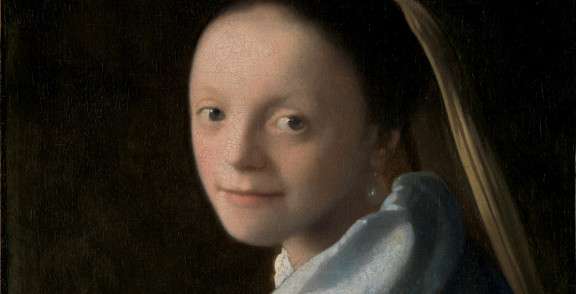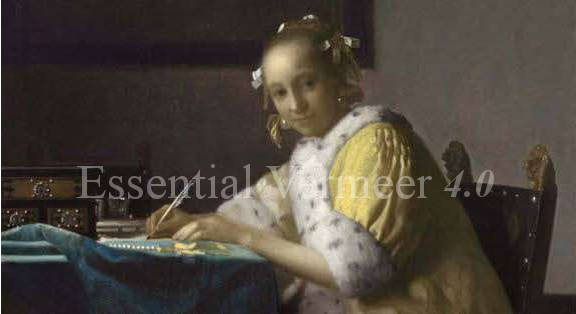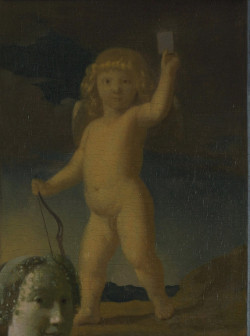A Lady Seated at a Virginal
c. 1670–1675Oil on canvas
51.5 x 45.5 cm. (20 1/4 x 17 7/8 in.)
National Gallery, London
In A Lady Standing at a Virginal and A Lady Seated at a Virginal, Vermeer avoided the unsettled compositional schema of The Guitar Player. As with his choice of subject matter and iconography, he reverted to his paintings of the mid-1660s for restrained, balanced compositions. The pose used for this work, for example, was essentially that of A Lady Writing. Although this dependency on earlier models suggests that Vermeer's creative energy had begun to lag, he had little choice but to return to these prototypes, being by nature an artist who felt most comfortable in a balanced, measured environment. He could not express the natural movement of a figure in a relaxed pose with the ease of Metsu or a Steen. His attempt to expand his types of composition in The Guitar Player resulted in an interesting but awkward painting.
In his late works, Vermeer's interest in the surface appearance of objects had contradictory effects. His brushwork became more abstract (fig. 2) as it was freed from the role of describing surface textures. A Lady Seated at a Virginal is the most extreme example of this approach in his oeuvre and thus probably was his last painting. The highlights on the gilded picture frame and on the lady's blue dress are as much abstract patterns of color as definitions of structure. Throughout the painting, the color has an extremely vivid, pure quality. This same concern for surface patterns and the resulting simplification of forms, however, resulted in figures who remain bland and expressionless (fig. 1). None of the nuances of human psychology in his earlier works are present here.
These last two paintings, in subject matter and style, are in many respects a natural culmination of Vermeer's evolution as an artist. While they contain echoes of much of his preceding work, they expand upon them, particularly in the abstraction of the brushwork. Whether or not these paintings are superior to his earlier work is another question Vermeer's genius rests on the delicate interrelationship between human psychology and compositional pattern. In these late works his attention to individual human attributes was subordinated to design and color, and an important element of Vermeer's uniqueness as an artist was lost.
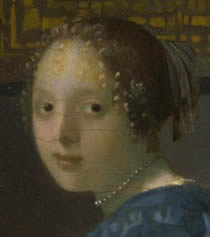 fig. 1 A Lady Seated at a Virginal (detail)
fig. 1 A Lady Seated at a Virginal (detail)Johannes Vermeer
c. 1670–1675
Oil on canvas, 51.5 x 45.5 cm.
National Gallery, London
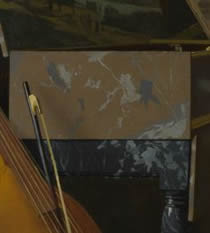 fig. 2 A Lady Seated at a Virginal (detail)
fig. 2 A Lady Seated at a Virginal (detail)Johannes Vermeer
c. 1670–1675
Oil on canvas, 51.5 x 45.5 cm.
National Gallery, London
The paintings of a Woman standing at the virginal and a Woman seated at the virginals in the National Gallery, London, are virtually identical in size but scholars are uncertain whether they are to be seen as a pair. In particular, it has been questioned whether such similar subjects would have been intended to be hung together. One scholar settled the matter by dating the works four years apart and claiming that while the Woman standing at the virginals was "one of the master's finest works," the Woman seated at the virginals, which he said was painted in the year of the artist' death, "shows a noticeable decline in Vermeer's powers."
It is true that the pieces appear to have led separate existences until the nineteenth century. One may have been in the Van Ruijven collection, being that listed as item 37, "a young woman playing the clavecin." The other could, possibly, have been that sold in Antwerp on 12 July, 1682 from the collection of the late Diego Duarte, a jeweler and banker: item 182, "a piece with a lady playing the clavecin with accessories by Vermeer…". They were brought together only in 1867, when Thoré bought the Woman seated at the virginal from the Pommersfelden collection, where it had been for over a century, to join the Woman standing at the virginals that he already owned. It was of the Woman standing at the virginals that Thoré wrote: "Often in Vermeer, one sees over the bed the Abduction of the Sabines—fortunate Sabines to be abducted by those strong Romans thinks the love-sick beauty, no doubt. In the Weigher of pearls by Vermeer, the picture in the background represents the Last Judgment: And his way bringing her a love letter. Unaffectedly anxious, she hopes, she improvises on the piano, awaiting the arrival of love."
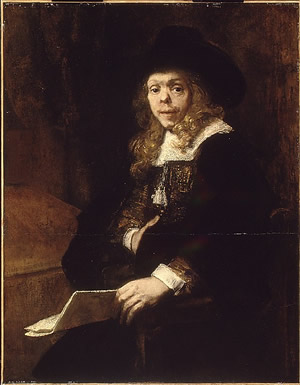 fig. 3 Portrait of Gérard de Lairesse
fig. 3 Portrait of Gérard de LairesseRembrandt van Rijn
Mid-1660s
Oil on canvas, 112.7 x 87.6 cm.
Metropolitan Museum of Art, New York
"All this without resorting to emblems. Beware, nevertheless, of Gérard de Lairesse and his mythological epics which are close at band. This naked Love, with his bow used as a walking cane, could well be by de Lairesse (fig. 3). Happily, with Vermeer, one only discovers these small allegorical niceties after one has understood everything simply from the expressions of the personages." The works were separated again in 1892, following Thoré's death, and it was not until 1910 that they were permanently reunited.
The two pieces clearly have much in common. The two women appear to be quite different but they wear similar costumes of the 1670s, the seated player wearing an additional overskirt. The instruments might be identical except for the landscapes painted on their raised lids. Then, the room in which they play is the same room but with the window covered in the one case. This last point, though, is curious. As has already been noticed, though it would seem that Vermeer used the same interior for many of his paintings, he did not hesitate to modify what might have been thought to have been permanent features. Both National Gallery paintings have floor tiles and a skirting of Delft tiles like those in the Beit Letter-writer but the pattern of leading in the window is that seen in the much earlier Frick Soldier and laughing girl. In similar cases...Vermeer seems not have hesitated to alter the relation of windows to rear wall. What, then, is the significance in the case of the Woman seated at the virginals of the window being curtained rather than simply eliminated? Was it to establish a final point of continuity and contrast between the two works? The similarities and differences in imagery between the works have been represented at the keyboard, though the latter usually plays a portative organ. It is apparent that the National Gallery paintings are linked by the theme of music and that of love. Love, as is well known, teaches music. Behind the standing woman is a picture of the god of love (fig. 5), Cupid, painted in the manner of Cesar van Everdingen (fig. 6), which could be the painting of Cupid listed in the inventory following Vermeer's death "above in the back room." Cupid holds up what appears to be a playing card (fig. 4) and this, though blank, has been interpreted by scholars as intended to represent an ace (of hearts, possibly) and thus symbolize the virtue of singleness of heart. This has been contrasted with the presence, behind the seated player, of van Baburen's Procuress which suggests she represents mercenary love. Whether it is appropriate to see the paintings on the wall as reflecting so directly on the characters of the two players has been questioned, though Leonard Slatkes has pointed out that "upright" carries the same moral overtones in Dutch as it does in English.
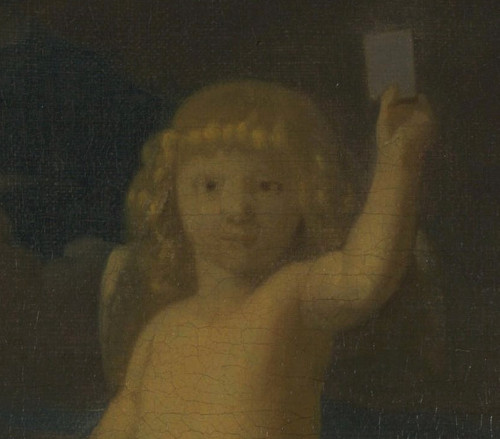 fig. 4 A Lady Standing at a Virginal (detail)
fig. 4 A Lady Standing at a Virginal (detail)Johannes Vermeer
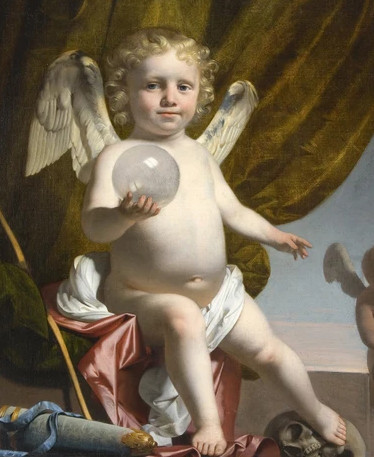 fig. 6 Amor Holding a Glass Orb
fig. 6 Amor Holding a Glass OrbCesare van Everdingen
c. 1660
Oil on canvas, 89 x 102 cm
Private collection
The style of the Everndigen's work compares well to that of the Cupid in the background of Vermeer' Lady Seated at a Virginal.
Whether the two paintings were intended as pendants and, if so, whether they were meant to be seen as contraries is not documented, of course. Good fortune rather than design appears to have brought them together in the National Gallery. But seen together, there can be little argument that they do appear as contraries. There is the obvious contrast in pose between standing and sitting. There is the contrast in orientation and the position of the instrument, so that the players face in apposite directions: it is this that makes this pair more apparently pendants than the paintings of The Astronomer and Geographer. There is the difference that the standing player has before her an empty chair while the seated player has by her instrument a bass viol, its bow held between its strings, ready for someone to join her in a duet. The seated woman plays from a score while the standing woman plays by heart.
Then again, the two women are set in very different relationship to the picture on the wall behind them. The standing player's head is virtually enclosed by the black frame linking her with the figure of Cupid, drawing attention to their shared upright stance, that each is alone at the centre of their individual picture, each directly meeting the eye of the viewer. The woman stands in close relationship to the painted Cupid behind her. The relation of the seated player to Van Baburen's Procuress is far less striking or obvious. The painting hangs above and behind her, hardly more than a dimly visible decorative furnishing. It is noticeable, though, that the proportions of The Procuress are different from the version included in the Boston Concert, so ensuring that; all three characters in the van Baburen are included and identifiable. Then again, the features of gallant and procuress are discernible while the face of the grinning whore is reduced to little more than a pale patch above the head of the seated player. Does the painting hover thus over her head like an image of her thoughts as she stares inscrutably into the eyes of the viewer?
A Lady Seated at a Virginal and Vermeer's final years of struggle
Nothing has been said so far about the impact of Vermeer's personal life on his art in these last years. Was he able to concentrate on his painting now that he had to bustle about in Delft, Gouda, and Amsterdam on family business all that he had to worry about food, schooling, and medicine for his children?
One thing that we can judge with our own eyes is this. A Lady Seated at a Virginal, considered to be his last painting because it progressed further along the path of stylization and simplification of modeling characteristic of his late work, betrays some falling off in the quality of its execution. As Blankert observed in his book on Vermeer "the folds of the costume are now harsh and coarsely executed, and the blots making up the frame of the painting on the black wall lack the sureness of touch [of his earlier work]." Was this decline due to the harried circumstances of his life in this last period? This is plausible, but I am more tempted to conjure up an explanation inherent in the work itself. In his last paintings, Vermeer seems to have lost the confidence, the inner conviction that imparted life energy to his art. The Allegory of Faith is labored and contrived, a chore accomplished rather than a joyful effusion. A Lady Seated at a Virginal lacks force. It is as if Vermeer, having worked out his obsessions—the intimate urgings that had prompted him to paint with exquisite precision pensive women pent up in shallow spaces—had, in the end, shed his passionate interest in representing these silent scenes.
from:
John Michael Montias
Vermeer and His Milieu: A Web of Social History, Princeton, NJ: Princeton, 1989, p. 215.
